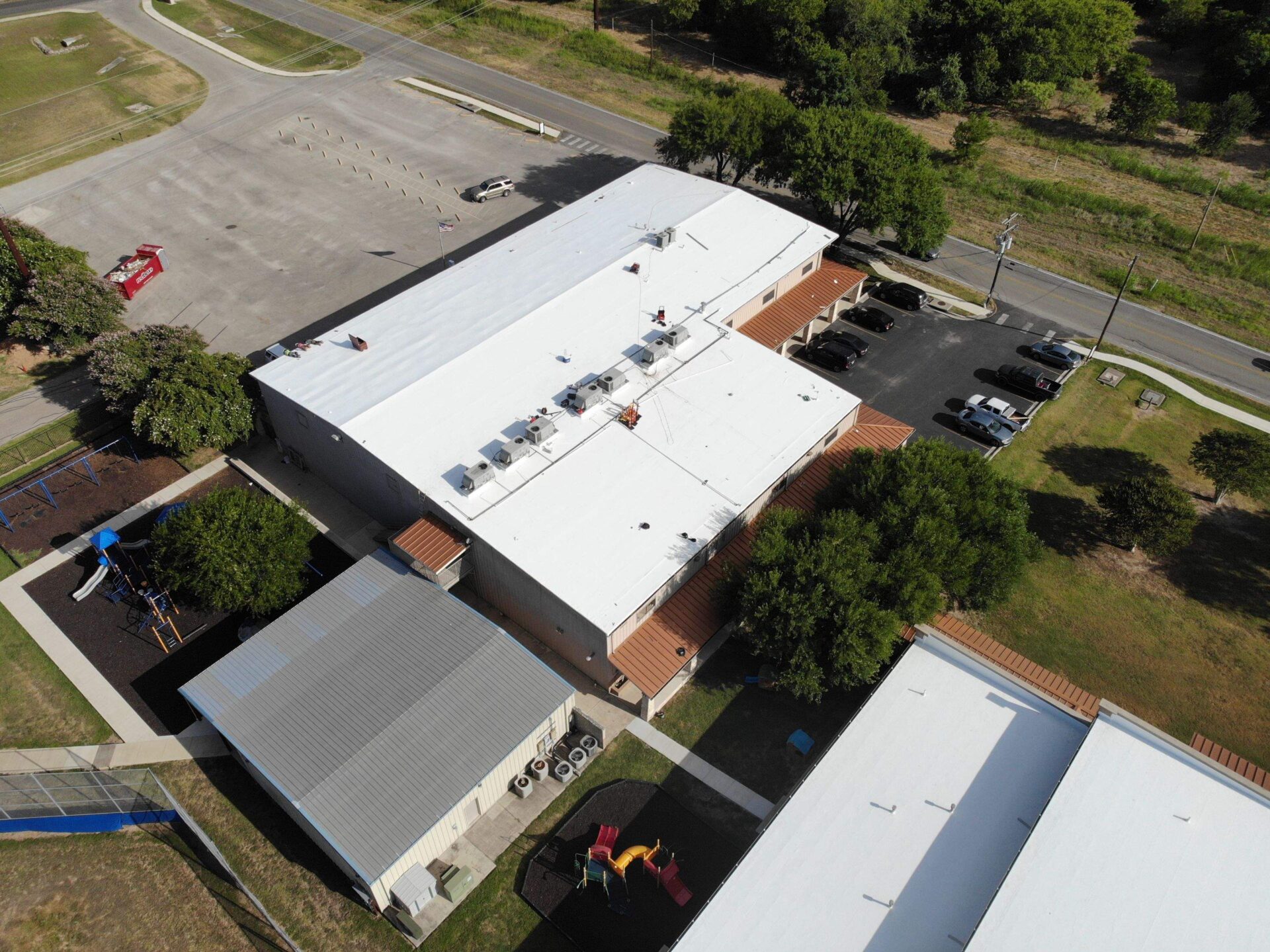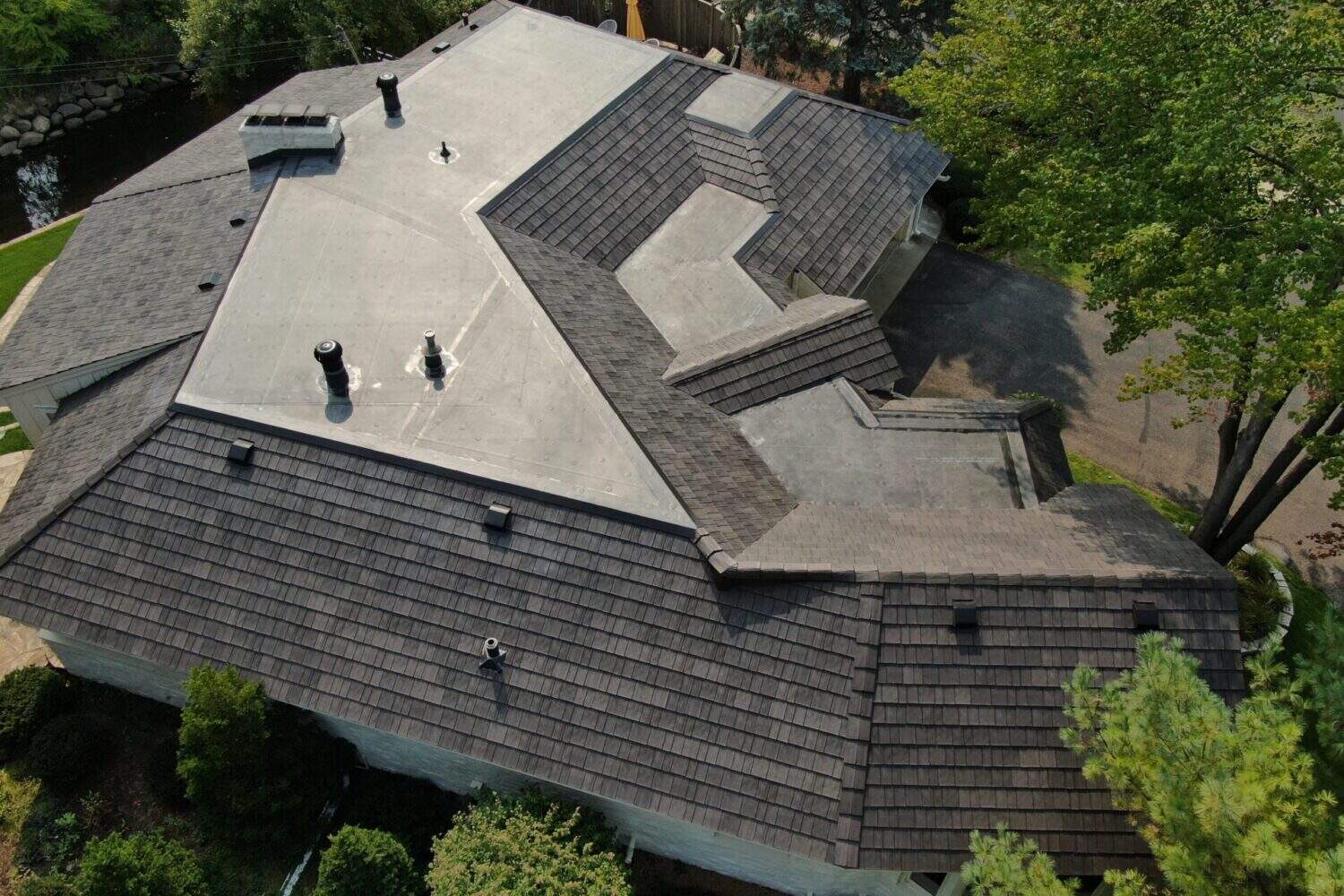The roof is the unsung hero of any building. It shields us from the elements, so without it, we’d be left to the mercy of rain, snow, and hail pelting us from above.
Because there are so many different kinds of roofing systems, it can be tough to pick one that works the best for your type of property and your vision. So, in this article, we’re going to talk about one kind of roofing system that comes with many benefits– the ballasted roof.
Let’s explore this type of roof and why it may be the perfect solution for your next roofing project.
What’s a ballasted roof?
If you’re wondering, “What is a ballasted fixture or roof?”– join the club of nearly everyone who isn’t a roofing or construction professional. While you may have not heard of ballast roof details, it doesn’t mean you haven’t seen one of these roofs before. So, let’s talk about what it is.
Although these roofs can technically be used on houses, they’re not usually the go-to choice for residential roofing. Rather, they’re more commonly used on large commercial and industrial buildings due to their ability to handle heavy foot traffic and their cost-effectiveness for large-scale projects.
This type of roof is a protective membrane (sometimes a rubber sheet) that’s loosely laid onto a flat roof. The layers that make up this roofing system– the roofing membrane, insulation, and roof deck– aren’t fastened to each other. In other words, the roof membrane isn’t anchored or attached to the decking material.
While it might seem like we’re describing a magical, floating roof, there’s science behind these unanchored roofs that make them function very well.
So, a ballasted roof isn’t attached…how does that work?
These roofs are ballasted, i.e., counterbalanced with a ballast material to keep them in place. Typically, the ballast on the roof is gravel, although it could be stones or pavers as well. The reason why gravel on roofs is the most common ballast material is that gravel is very resilient to high winds and heavy foot traffic. Likewise, the weight of the gravel is excellent at anchoring down the roof materials.
Once the membrane is in place, the layer of ballast material that’s several inches thick is evenly spread over it. The ballast helps to weigh down the roofing membrane and keep it in place, providing resistance against wind uplift and water infiltration.

default
Benefits of a ballasted membrane roof
While ballasted roofs may not be as well-known as other types of roofing systems, they offer a range of benefits that make them an excellent choice for many building owners. Thus, this type of roofing system has been gaining popularity in recent years due to its many benefits. From their durability to their unique style, these unanchored roofs offer perks that make them an attractive choice for commercial and industrial properties.
Easy to install
A roofing ballast is pretty easy to install compared to other roofing systems because it doesn’t require a bunch of adhesives and fasteners. This also makes the installation process relatively quick.
Moreover, without the need for specialized tools or equipment, they’re an ideal choice for large commercial or industrial buildings, where speed and efficiency are critical.
Easy to repair
As the ballasted roof is easy to install, it’s also easy to repair or remove and reinstall. Separating the ballasted system roofing components is very feasible since there’s no special equipment or materials anchoring them together.
Flexible scheduling
Whether it’s a gravel, concrete, or stone ballast roof– this type of roof can be built during any season. Unlike some other roofing systems that require specific temperatures and weather conditions for installation, these loose-laid roofs can be installed year-round. Why? Because the installation process doesn’t require the use of adhesives or heat welding, which can be affected by temperature and humidity. Thus, the scorching summer sun won’t disrupt the ballast construction process.
Likewise, the ballast layer on top of the roofing membrane provides additional weight and stability. This prevents the roof from being damaged by wind or other weather conditions during the installation. So, even during the icy-cold winter months, it can be installed efficiently and effectively.
No smells
No one likes going into work when they can smell the current construction work being done on the building. This is why a huge benefit of ballasted roof details is that the installation process comes without any offensive smells. The reason why there aren’t any unpleasant smells with roofing ballast stone, gravel, or concrete, is that there’s no need for heat or adhesives that typically cause odors.
Versatile
These types of roofs are versatile roofing options that can be used for a variety of commercial and industrial buildings. Not only do they offer a diverse range of functionalities, but they also provide versatile designs.
Purpose
If you’re contemplating a ballasted vs non–ballasted roof, an advantage of the former is that they provide a variety of purposes. So, while a roof may just be a roof for other commercial properties, this type of roof can provide a function that goes beyond shielding your building from the elements.
For example, a concrete paver-ballasted design can function as an outdoor space to socialize. It could become a plaza, a green landscape area, or even a barbecue hotspot.
Aesthetics
Whether you’re building with roofing ballast stone, gravel, or concrete, the final product will be a natural-looking surface. Thus, it can seamlessly blend with a variety of architectural styles and color schemes.
Also, these roofs can be designed with different patterns or textures to add visual interest and enhance a building’s aesthetic appeal. So, whether you’re looking for a sleek and modern appearance or a more traditional and rustic look, you can tailor these roofs to match your building’s architectural style.
Eco-friendly
In 2023, everyone loves any type of project that reduces our environmental footprint. So, the fact that ballasted roofs are considered to be an eco-friendly roofing option is an attractive benefit. Let’s go over why they’re a friend to our ecosystem.
The components that make up a ballast roof system are often made from recycled materials, like rubber or plastic. Also, the ballast layer that’s on top of the roofing membrane is usually gravel, which can also be recycled. This pattern of recycling means that fewer resources are needed to produce these materials, and in turn, less waste is generated during the manufacturing process.
Furthermore, these unanchored roofs provide excellent insulation and help to reduce the amount of energy required to heat or cool a building. This reduces the building’s carbon footprint. Finally, because these types of roofing systems have longer lifespans than some other roofing systems, they require less frequent replacement. As a result, the amount of waste generated from roofing materials is reduced over time. All of these factors make these roofs a more eco-friendly choice for commercial and industrial roofing.
Durable
If you’re thinking that these loose-laid roofs would be the first to fly off in a ‘Wizard of Oz’ tornado– think again. The roof ballast thickness makes it extremely durable and gives it longevity.
This kind of roof is known by architects for its exceptional durability and ability to withstand extreme weather conditions. The combination of the roofing membrane and the ballast layer provides a sturdy and stable ballast roof weight and roofing system. Thus, it can handle heavy foot traffic and resist damage from high winds, hail, and other weather events.
Additionally, the ballast layer protects against UV rays, which can cause damage to roofing materials over time. This, in turn, helps to extend the lifespan of the roofing system and reduce the need for frequent repairs or replacement.
Why we’ll start seeing more ballasted roofs
All in all, the many advantages that these loose-laid roofs offer make it plausible that we’ll see more of them in the future. As functional outdoor spaces become a popular selling point for commercial properties, a rise in these durable and multi-purpose roofs will result.
So, what’s stopping you from getting a ballasted fixture for your commercial or industrial building? If you have questions, we have answers. Reach out to Summit Construction Group today to learn more about finding your perfect roofing solution.

